 Website:
Vernacare
Website:
Vernacare
Catalog excerpts

SWITCH? EVIDENCE PACK
Open the catalog to page 1
This document combines a body of evidence which supports the sustainable use of Vernacare disposal units and pulp products. Our evidence is segmented into several key areas, including -• Environmental • Staff Benefits • Infection prevention • Waste water Full copies of the evidence included can be provided, on request.
Open the catalog to page 3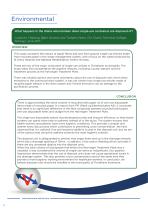
Environmental What happens in the drains when broken down single-use containers are disposed of? (Joachim Yttereng, Bjørn Nordvik and Torbjørn Moen, Chr Thams Technical College, Norway) June 2017 OVERVIEW This study considers the impact of paper fibres and wax from ground single-use articles made from recycled paper in the waste management system, with a focus on the waste produced by St Olavs Hospital and Søbstad Rehabilitation Centre, Norway. These are two of the major consumers of single-use articles in Trondheim municipality. The study takes into consideration the pipeline network,...
Open the catalog to page 4
Power and Water Comparison Test (Bernard G Boulton PTY Ltd, Consultant Engineers, Australia) July 2001 OVERVIEW Compare the power and water consumption of pan sanitising system against the Vernacare disposable pan macerator system. Recording equipment was fitted to two pan sanitisers and to a Vernacare macerator unit. The energy and water consumption was recorded over a number of cycles. CONCLUSION The Vernacare system used 96.50% less power than that required in operating the existing pan sanitisers. The saving is further enhanced as the Vernacare system has the capacity to process up to 4...
Open the catalog to page 5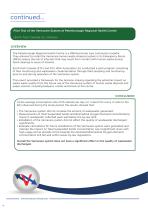
continued... Pilot Test of the Vernacare System at Peterborough Regional Health Centre (Earth Tech Canada Inc, Ontario) OVERVIEW The Peterborough Regional Health Centre is a 399-bed acute care community hospital. They planned to install the Vernacare human waste disposal system in its Emergency Room (ER)to reduce the risk of infection that may result from contact with human waste during hand cleaning or reuse of utensils. Earth Tech Canada (ETC) and D.M. Wills Associates Ltd. conducted a pilot program consisting of flow monitoring and wastewater characterisation through field sampling and...
Open the catalog to page 6
Staff Benefits Evaluation of the time factors in the use of the Vernacare Macerator (Associate Professor Sally Garratt and Ms Judith Coles, R.N, Caulfield General Medical Centre, North Vic, Australia) OVERVIEW Objective of the study was to provide an examination of the time involved in the use of the Macerator compared to the standard Pan Flusher / Sanitiser that was in use at the time. A structured observational approach was used to monitor the use of both the macerator and the pan flusher/sanitiser, to understand the total number of uses per shift, pattern of usage including; collection...
Open the catalog to page 7
continued... Disposable single-use receptacles in a tertiary hospital: A large survey of staff after a hospital-wide implementation (Mei Yen Phau, Sharon Salmon, Paulin Straughan and Dale Fisher, National University Hospital, Singapore) OVERVIEW In March 2014, a 1,100-bed tertiary hospital fully converted from a traditional system of reusable receptacles to a single-use disposable pulp receptacle system. Almost 12 months later, in February 2015, we undertook a large survey questionnaire to investigate user acceptance, perceptions, and any areas for improvement. The disposable pulp...
Open the catalog to page 8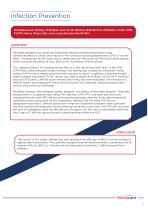
Infection Prevention Simulated-use Testing of Bedpan and Urinal Washer Disinfectors (Michelle J Alfa, PHD, FCCM, Nancy Olson, BSc and Louise Buelow-Smith RN) OVERVIEW Reusable bedpans and urinals are frequently cleaned and decontaminated using washer-disinfectors (WDs) that may be in the central processing department (CPD) or on the ward. The objective of this study was to determine how efficiently the WDs provided cleaning and to evaluate the ability of such WDs to kill Clostridium difficile spores. The cleaning efficacy of 2 bedpan/urinal WDs (1 in the ward [ward-WD] and 1 in the CPD...
Open the catalog to page 9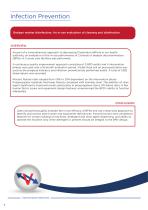
Infection Prevention Bedpan washer disinfectors: An in-use evaluation of cleaning and disinfection OVERVIEW As part of a comprehensive approach to decreasing Clostridium difficile in our health authority, an evaluation of the in-use performance of 2 brands of bedpan decontaminators (BPDs) in 2 acute care facilities was performed. A continuous quality improvement approach consisting of 5 BPD audits and 4 intervention phases was used over a 16-month evaluation period. Visible fecal soil on processed items was used as the progress indicator, and infection preventionists performed audits. A...
Open the catalog to page 10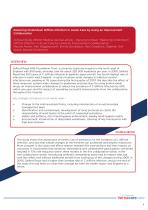
Reducing Clostridium Difficle Infection in Acute Care by Using an Improvement Collaborative (Clincal Study: British Medical Journal article – document titled, “Reducing Clostridium Difficle Infection in Acute Care by Using an Improvement Collaborative” Maxine Power, Neil Wigglesworth, Emma Donaldson, Paul Chadwick, Stephen Gillibrand, Donald Goldmann) OVERVIEW Salford Royal NHS Foundation Trust, a university teaching hospital in the north west of England with 850 beds, provides care for about 320 000 inpatients per year. In 2006, Salford Royal had 350 cases of C difficile infection in...
Open the catalog to page 11
continued... Aerosolisation Testing: ASSESSMENT OF VERNACARE VORTEX HOSPITAL MACERATOR (Aston University, 2011) OVERVIEW To investigate aerosol production and the escape of fluid from the lid seal of the Vernacare Vortex hospital macerator during use. CONCLUSION When tested for 4 consecutive cycles, the Vernacare Vortex hospital macerator did not produce any aerosols or contaminate any adjacent user accessible areas. Full report available for Vernacare’s complete macerator range Measurement of microbial contamination of plastic hospital washing bowls (PA Lambert, Professor of Microbiology)...
Open the catalog to page 12
RESULTS Organisms isolated from the samples A number of different colonies were obtained from the swabs taken from each bowl sample. In both cases higher numbers of organisms with a greater diversity of colonial appearance were obtained when samples were incubated at 25°C compared with those incubated at 37°C. This indicates that the samples contained environmental organisms (optimum growth at 25°C) rather than human pathogens (optimum growth at 37°C). Sample A: one plastic wash bowl as supplied. Swab from bowl A incubated at 25°C for 3 days on blood agar. Two large fungal colonies (white...
Open the catalog to page 13All Vernacare catalogs and technical brochures
-
Conti® Post Toileting Flyer
1 Pages
-
Conti® Hands and Face Flyer
4 Pages
-
Vortex Air Battle Cards
4 Pages
-
Vortex Air Brochure
6 Pages
-
Compact+ Brochure
6 Pages
-
ComfiWear™ Garments Guide
3 Pages
-
Vortex Brochure
12 Pages
-
ComfiKIDS Garment Guide
5 Pages
-
Surgical Bert Range
5 Pages
-
Male Urinal Lid
1 Pages
-
Product Brochure
12 Pages
-
Azo wipes
11 Pages
-
VernaGel
2 Pages
-
INTELLIGENT SKIN CARE
3 Pages
-
PROCEDURE PACKS
28 Pages
-
Compact Range brochure
10 Pages
-
TRAY LINER
2 Pages
-
CREPE
2 Pages
-
AZOWRAP™
2 Pages
-
Procedure Packs
28 Pages
-
switched facilities
10 Pages
-
Waste maintenance
2 Pages
-
Environmentally friendly
2 Pages
-
Infection prevention
2 Pages
-
Antibiotic resistance
2 Pages
-
VernaGel-
2 Pages







































